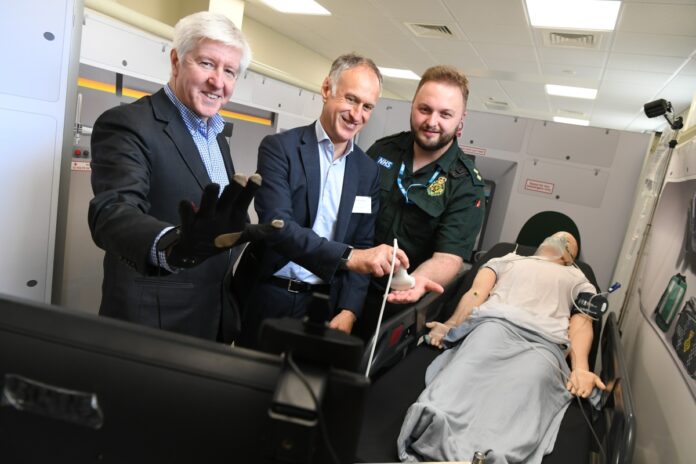University Hospitals Birmingham NHS Foundation Trust (UHB), BT and WM5G showcased the UK’s first demo of a remote-controlled ultrasound over public 5G.
The event aimed to bring the concept of a 5G connected ambulance to life and demonstrate how new technologies can help front-line staff better diagnose patients faster.
The demonstration follows a decision by Government to select the West Midlands as the UK’s first multi-city 5G testbed. WM5G, which is headed by former president of Nokia Global Services, Igor Leprince, leads this work.
How it works
The demonstration simulated a paramedic in the field performing an ultrasound scan on a patient, under the remote guidance of a clinician who interpreted the ultrasound image in real-time.
The ultrasound sensor is manipulated locally by the paramedic under the remote direction of the clinician. This is done using a joystick operated remotely by the clinician which sends control signals over the live 5G network to a robotic or ‘haptic’ glove worn by the paramedic.
The glove creates small vibrations that direct the paramedic’s hand to where the clinician wants the ultrasound sensor to be moved. This allows the clinician to remotely control the sensor position, whilst seeing the ultrasound images in real-time.
In addition, there is a camera in the ambulance which transmits high-definition view of the inside of the ambulance, covering the patient and paramedic, to a second screen located on the clinician’s workstation.
The images are relayed over a high-bandwidth 5G connection, so the clinician is able to view both the ultrasound examination performed by the paramedic and keep an eye on the overall scene inside the ambulance.
5G’s speeds ensure sharper and more reliable imagery for the clinician than could previously be achieved.
First healthcare trial
Gerry McQuade, CEO of BT’s Enterprise unit, said: “We’re really excited to be working with WM5G and University Hospitals Birmingham on the first 5G healthcare trial to take place in the UK over a live public network.
“We are focused on delivering new, innovative services which will make lives better and firmly believe in using the power of 5G to bring potentially life-saving benefits to patients.
“There’s no better place to start realising this vision than in Birmingham, part of the UK’s first multi-city 5G test bed.”
Benefits
Enabling ultrasound scans to be performed by paramedics in the field and reviewed remotely by an expert clinician has the potential to speed up diagnoses for patients, as well as reduce the number of ambulance journeys and emergency department visits.
Tim Jones, Chief Innovation Officer at UHB, said, “We are immensely excited about the potential of 5G to support transformation in healthcare.
“As a Global Digital Exemplar, we are always looking into new technologies and how we can use them to improve patient care. 5G will help us to roll out this next generation of healthcare technologies.
“Our clinicians will in the future be able to deliver holistic specialist advice in real time, potentially forming virtual multi-disciplinary teams to provide the best patient care using intelligent IT links.
“Information would be accessible at the point of need, ensuring informed decision making leading to improved patient safety, quality of care and patient/clinician experience.”
The demonstration took place at the Medical Devices Testing and Evaluation Centre (MD-TEC) in UHB’s simulation lab located in the Institute of Translational Medicine.



